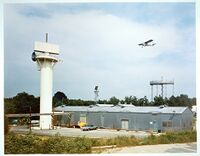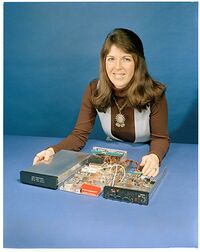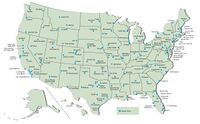Milestone-Proposal:Development of the Mode S Next-Generation ATC Radar Beacon System
To see comments, or add a comment to this discussion, click here.
Docket #:2022-03
This Proposal has been approved, and is now a Milestone
To the proposer’s knowledge, is this achievement subject to litigation? No
Is the achievement you are proposing more than 25 years old? Yes
Is the achievement you are proposing within IEEE’s designated fields as defined by IEEE Bylaw I-104.11, namely: Engineering, Computer Sciences and Information Technology, Physical Sciences, Biological and Medical Sciences, Mathematics, Technical Communications, Education, Management, and Law and Policy. Yes
Did the achievement provide a meaningful benefit for humanity? Yes
Was it of at least regional importance? Yes
Has an IEEE Organizational Unit agreed to pay for the milestone plaque(s)? Yes
Has the IEEE Section(s) in which the plaque(s) will be located agreed to arrange the dedication ceremony? Yes
Has the IEEE Section in which the milestone is located agreed to take responsibility for the plaque after it is dedicated? Yes
Has the owner of the site agreed to have it designated as an IEEE Milestone? Yes
Year or range of years in which the achievement occurred:
1969 through 1995
Title of the proposed milestone:
Mode S Air Traffic Control Radar Beacon System, 1969-1995
Plaque citation summarizing the achievement and its significance; if personal name(s) are included, such name(s) must follow the achievement itself in the citation wording: Text absolutely limited by plaque dimensions to 70 words; 60 is preferable for aesthetic reasons.
In 1969, MIT Lincoln Laboratory began developing the Mode S selective secondary surveillance radar beacon system to enable safe air traffic control in busy, spectrum-congested airspace. This technology made more efficient use of the radio spectrum than previous systems. By 1995, the Mode S techniques and transmission codes became the worldwide standard for air traffic control radars.
200-250 word abstract describing the significance of the technical achievement being proposed, the person(s) involved, historical context, humanitarian and social impact, as well as any possible controversies the advocate might need to review.
IEEE technical societies and technical councils within whose fields of interest the Milestone proposal resides.
In what IEEE section(s) does it reside?
Boston Section
IEEE Organizational Unit(s) which have agreed to sponsor the Milestone:
IEEE Organizational Unit(s) paying for milestone plaque(s):
Unit: IEEE Boston Section
Senior Officer Name: Denise Griffin, 2022 IEEE Boston Section Chair
Unit: IEEE Boston Section
Senior Officer Name: Gilmore Cooke, Boston Section Milestone Coordinator
Unit: IEEE Boston Section
Senior Officer Name: Robert J. Alongi, Jr., Business Manager
IEEE Organizational Unit(s) arranging the dedication ceremony:
Unit: IEEE Boston Section
Senior Officer Name: Denise Griffin, 2022 IEEE Boston Section Chair
Unit: IEEE Boston Section
Senior Officer Name: Gilmore Cooke, Boston Section Milestone Coordinatorr
Unit: IEEE Boston Section
Senior Officer Name: Robert J. Alongi, Jr., Business Manager
IEEE section(s) monitoring the plaque(s):
IEEE Section: IEEE Boston Section
IEEE Section Chair name: Denise Griffin, 2022 IEEE Boston Section Chair
Milestone proposer(s):
Proposer name: James Flavin, Division Head, MIT Lincoln Lab
Proposer email: Proposer's email masked to public
Please note: your email address and contact information will be masked on the website for privacy reasons. Only IEEE History Center Staff will be able to view the email address.
Street address(es) and GPS coordinates in decimal form of the intended milestone plaque site(s):
244 Wood Street, Lexington, MA 02421 (coordinates in decimal degrees: 42.459061, -71.266997)
Describe briefly the intended site(s) of the milestone plaque(s). The intended site(s) must have a direct connection with the achievement (e.g. where developed, invented, tested, demonstrated, installed, or operated, etc.). A museum where a device or example of the technology is displayed, or the university where the inventor studied, are not, in themselves, sufficient connection for a milestone plaque.
Please give the details of the mounting, i.e. on the outside of the building, in the ground floor entrance hall, on a plinth on the grounds, etc. If visitors to the plaque site will need to go through security, or make an appointment, please give the contact information visitors will need. Main Lobby, MIT Lincoln Laboratory
Are the original buildings extant?
yes
Details of the plaque mounting:
Main entrance area, in a display case. Lobby is at the base of the hill where the Mode S prototype was installed
How is the site protected/secured, and in what ways is it accessible to the public?
MIT Lincoln Laboratory is a secure facility
Who is the present owner of the site(s)?
Massachusetts Institute of Technology
What is the historical significance of the work (its technological, scientific, or social importance)? If personal names are included in citation, include detailed support at the end of this section preceded by "Justification for Inclusion of Name(s)". (see section 6 of Milestone Guidelines)
The original Air Traffic Control Radar Beacon System (ATCRBS) was in widespread use across the Air Traffic Control system. However, by the late 1960s, the rapid growth in aviation necessitated the development of a spectrum-efficient technical solution to accommodate reliable aircraft surveillance in regions with high traffic densities. The Mode S design introduced the selective interrogation of addressable transponders, a datalink between the cockpit and ground systems, and improved azimuth, altitude, and range resolution. An expansive, backward compatible design and prototype was developed for both the radar system and the avionics units. This work was performed at MIT Lincoln Laboratory and demonstrated at the Mode S Experimental System in Lexington Massachusetts. Eventually this design was adopted as an international standard and deployed at the major airports throughout the world.


What obstacles (technical, political, geographic) needed to be overcome?
The then state of the art was ATCRBS operating on 1030 MHz uplink and 1090 MHz downlink. This prior radar beacon system needed up to 16 replies as the radar beam swept the target in order to support sliding window beamsplitting to obtain an estimate of the target’s azimuth and resulted in a high level of replies from surrounding interrogators that interfered with the reception of the aircraft transponder replies at the local interrogator. ATCRBS also used broadcast interrogations so that every aircraft in the antenna beam replied. The replies from aircraft within 2 nm slant range of each other resulted in overlapping replies at the receiver, making them difficult to detect. This situation was especially serious when the radar systems were providing surveillance on aircraft in a holding stack. In 1969, the Air Traffic Control Advisory Committee (ATCAC) predicted saturation of the ATCRBS reply frequency resulting from anticipated traffic growth. The committee recommended ATCRBS be upgraded with a new beacon system. The Federal Aviation Administration (FAA) tasked Lincoln Laboratory to develop such a system and an associated transponder.
What features set this work apart from similar achievements?
The MIT Lincoln Laboratory design included the following capabilities:
• Monopulse azimuth measurements, using sum and difference beams, enabling:
- Lower interrogation rates to reduce reply channel loading and transponder occupancy
- Improved reply detection using monopulse for correlation
- Improved azimuth accuracy
- Monopulse to be applied to Mode S and ATCRBS surveillance
• Mode S to operate transparently on 1030, 1090 MHz
- Mode S interrogations (to Mode S transponders) are not detected by ATCRBS transponders.
- Mode S transponders reply to ATCRBS interrogations from ATCRBS interrogators but not from Mode S interrogators.
• Discrete addressing of Mode S transponders, including
- An acquisition method for new targets, followed by addressed interrogations
- Efficient scheduling of discrete interrogations, and immediate retries if necessary
- Parity protection and error correction for Mode S signals
- Integral datalink, with 56 or 112 bits per message
- Pulse position modulation of the Mode S reply to provide the same number of pulses for monopulse, independent of the message content
• Top and bottom transponder antennas to mitigate banking fades
Why was the achievement successful and impactful?
Supporting texts and citations to establish the dates, location, and importance of the achievement: Minimum of five (5), but as many as needed to support the milestone, such as patents, contemporary newspaper articles, journal articles, or chapters in scholarly books. 'Scholarly' is defined as peer-reviewed, with references, and published. You must supply the texts or excerpts themselves, not just the references. At least one of the references must be from a scholarly book or journal article. All supporting materials must be in English, or accompanied by an English translation.
Vincent A. Orlando., “The Mode S Radar Beacon System”, MIT Lincoln Laboratory Journal, Volume 2, Number 3, 1989. Media:Mode_S_Radar_Beacon_System_Lincoln_Journal_Vol_2_Number_3.pdf
Edward M. Hofstetter and Darrol F. Delong, Jr., “Detection and Parameter Estimation in an Amplitude-Comparison Monopulse Radar”, IEEE Transactions on Information Theory, Vol. IT-15, No. 1, January 1969. Media:Detection and Parameter Estimation in an Amplitude-Comparison Monopulse Radar.pdf
D. A. Shnidman, “A Comparison of Immunity to Garbling for Three Candidate Modulation Schemes for DABS”, MIT Lincoln Laboratory, Project Report ATC-12, 14 August 1972, FAA-RD-72-84. Media:Shnidman_1972_ATC-12_WW-15318.pdf
P. R. Drouilhet, “Provisional Signal Formats for the Discrete Address Beacon System”, MIT Lincoln Laboratory Project Report ATC-30.1, 25 April 1974, FAA-RD-74-62. Media:Drouilhet_1974_ATC-30i_WW-15318.pdf
J. -C. Sureau, “A Summary of DABS Antenna Studies”, MIT Lincoln Laboratory, Project Report ATC-53, 3 February 1976, FAA-RD-75-112. Media:Summary of DABS antenna studies-1.pdf
T. J. Goblick, "DABS Modulation and Coding Design", MIT Lincoln Laboratory Project Report ATC-52, 12 March 1976, FAA-RD-75-93. Media:Goblick_1976_ATC-52_WW-15318.pdf
R. J. McAuley and V. Vitto, “A Simulation of the DABS Sensor for Evaluating Reply Processor Performance”, MIT Lincoln Laboratory, Project Report ATC-28, 16 September 1974, FAA-RD-74-123. Media:Mcaulay_1974_ATC-28_WW-15318.pdf
International Civil Aviation Organization, “International Standards and Recommended Practices, Annex 10 to the Convention on Civil Aviation, Aeronautical Telecommunications, Volume IV Surveillance and Collision Avoidance Systems”, Fifth Edition, Annex 10, Volume 4, July 2014. Media:International Standards and Recommended Practices, Surveillance and Collision Avoidance Systems, Annex 10, Volume 4.pdf
Supporting materials (supported formats: GIF, JPEG, PNG, PDF, DOC): All supporting materials must be in English, or if not in English, accompanied by an English translation. You must supply the texts or excerpts themselves, not just the references. For documents that are copyright-encumbered, or which you do not have rights to post, email the documents themselves to ieee-history@ieee.org. Please see the Milestone Program Guidelines for more information.
(1) Support letter from
- Dr. Eric Evans, the Director of MIT Lincoln Laboratory:
Media:Support_Letter_IEEE_Milestone_MIT_LL_Development_of_the_Mode_S_Next_Generation_ATC_Radar_Beacon_System_signed.pdf
(2) Support letter from
- 2022 IEEE Boston Section Chair, Denise Griffin, 44griffin@comcast.net
- IEEE Boston Section Milestone Coordinator, gilcooke@ieee.org
Please email a jpeg or PDF a letter in English, or with English translation, from the site owner(s) giving permission to place IEEE milestone plaque on the property, and a letter (or forwarded email) from the appropriate Section Chair supporting the Milestone application to ieee-history@ieee.org with the subject line "Attention: Milestone Administrator." Note that there are multiple texts of the letter depending on whether an IEEE organizational unit other than the section will be paying for the plaque(s).
Please recommend reviewers by emailing their names and email addresses to ieee-history@ieee.org. Please include the docket number and brief title of your proposal in the subject line of all emails.


